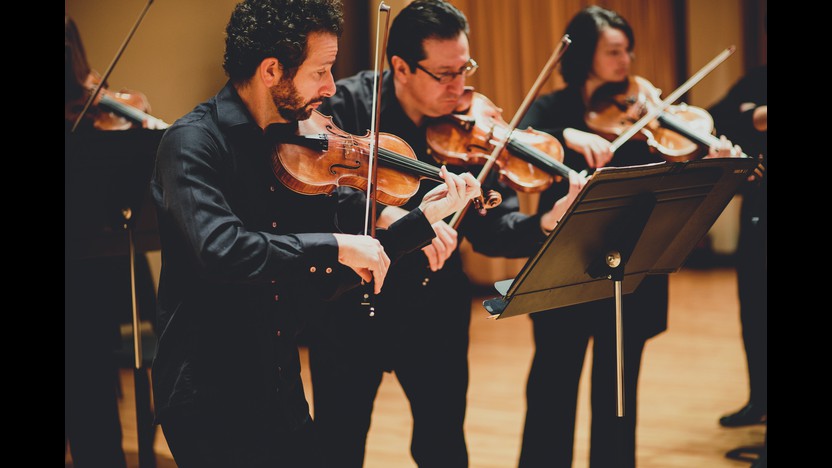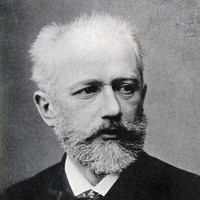Tchaikovsky’s Serenade for Strings



Prokofiev’s Five Melodies for Single Winds and Strings are a transcription of his Five Songs without Words, Opus 35, originally composed in 1920 for the mezzo-soprano Nina Koshetz. Certain hallmarks of Prokofiev’s language—namely, the impish and at times caustic wit that characterizes so much of his chamber and symphonic output—defer in these five miniatures to an unabashed lyricism. The composer was touring California while at work on the Songs without Words, and that state’s natural beauty may have had something to do with the character of these pieces; in his diary, the composer recorded his impression of “the ocean, which at sunset shimmered with the most beautiful colors.”
Their concentration of lyricism does not, however, preclude the Five Melodies’ expressive range. The dreamy wistfulness of the first leads naturally into the tender second movement, which for a brief moment shows its teeth; the third, in turn, marked Animato, launches a nervous frenzy. The fourth tune, equal parts sly delicacy and winsome charm, seems tailored for a Woody Allen film. The set concludes with the most enigmatic of the five: a dreamlike reverie, redolent of the first movement, momentarily offset by an angular middle section.
The Five Melodies honor three violinists who impelled their conception. Prokofiev first had the idea to compose a set of Songs without Words for violin and piano upon hearing the Hungarian virtuoso Joseph Szigeti in recital. A personal acquaintance, the violinist Cecilia Hansen, insisted that the second of the Opus 35 Songs would idiomatically fit the violin. Thus encouraged, Prokofiev consulted Pawel Kochánski, the muse for his First Violin Concerto, and produced transcriptions of the entire set in just two hours. The first, third, and fourth of the Five Melodies are dedicated to Kochánski; the second to Hansen; and the fifth to Szigeti.
These performances offer orchestrations of the Five Melodies by violinist and composer Michi Wiancko.
Patrick Castillo ©2015
 Listen to Audio
Listen to Audio
(Duration: 21 min)
Franz Joseph Haydn became a court composer for Austria’s wealthy Esterházy family in 1761, and four years later he was put in charge of all the court’s vast musical activities. His patron, Prince Nikolaus Esterházy, was an avid musician and a true supporter of the arts, but he kept his Kapellmeister on a tight leash, especially during the long stretches of time spent at an isolated summer palace where the musicians had to produce an endless stream of operas and other entertainment. Under those demands, Haydn later wrote, “I was forced to become original.”
In 1779, Haydn negotiated a new contract that gave him more leeway to compose and publish independently, and soon his music was attracting followers throughout Europe. One foreign admirer was a young French count, Claude-François-Marie Rigolet, who commissioned six symphonies that Haydn composed in 1785 and 1786. These “Paris” Symphonies earned Haydn the handsome sum of 25 louis d’or each, plus additional fees for publication. (By comparison, Wolfgang Amadeus Mozart earned only 5 louis d’or for his “Paris” Symphony from 1778.)
Haydn’s “Paris” symphonies capitalized on the large orchestra employed for the Concerts de la Loge Olympique, conducted by Joseph Bologne, Chevalier de Saint-Georges. In the Symphony No. 85, the slow introduction references the classic French overture with its majestic dotted rhythms and unison statements, details that show Haydn’s awareness of his intended audience. The Vivace body of the movement is a model of economy, with a small collection of themes that gain intrigue when placed in unexpected contexts, such as a surprise detour to F-minor on the way to the anticipated key of F-major.
The second movement Romanza was another local crowd-pleaser, with a set of variations on the French folksong La gentille et jeune Lisette. The Menuetto makes a game of chortling grace notes and offbeat accents, and its contrasting trio section strikes up the unlikely pairing of bassoon and violins over pizzicato. The same pairing returns to begin the Presto finale that bounds along with a particularly active and independent bass line. Queen Marie Antoinette purportedly loved this symphony the most of Haydn’s offerings for Paris, earning it the nickname “La Reine” (“The Queen”).
Aaron Grad ©2023
 Listen to Audio
Listen to Audio
“How fickle my plans are,” Pyotr Tchaikovsky wrote, “whenever I decide to devote a long time to rest!” Tchaikovsky’s time with his sister in Ukraine turned into a working vacation that summer of 1880, as he confided to his patron, Nadezdha von Meck. “I had just begun to spend a series of entirely idle days, when there came over me a vague feeling of discomfort and real sickness; I could not sleep and suffered from fatigue and weakness. Today I could not resist sitting down to plan my next symphony — and immediately I became well and calm and full of courage.”
Tchaikovsky’s plan for that music wavered between a symphony and a string quartet, until he landed on something in between: a serenade for string orchestra. The title and form of the work paid homage to Wolfgang Amadeus Mozart, the greatest composer of serenades, whom Tchaikovsky once praised as “the culminating point which beauty has reached in the sphere of music.”
The Serenade for Strings merges a Classical sense of order with Tchaikovsky’s own abundant gift for melodic expression. Despite the modest heading that promises a “Piece in the form of a Sonatina,” the first movement establishes a grand and noble tone with a reverent chorale. Instead of a minuet or scherzo, the second movement offers a flirtatious diversion in the form of a Waltz. The slow movement, labeled an Elegy, takes a more somber turn. In the finale, the “Russian theme” promised by the subtitle is an amalgamation of folk material that Tchaikovsky harvested from a printed collection.
Aaron Grad ©2021
Get driving directions and find nearby parking.
Find dining options close to the venue.
View seating charts to find out where you'll be seating.
Get driving directions and find nearby parking.
Find dining options close to the venue.
View seating charts to find out where you'll be seating.
